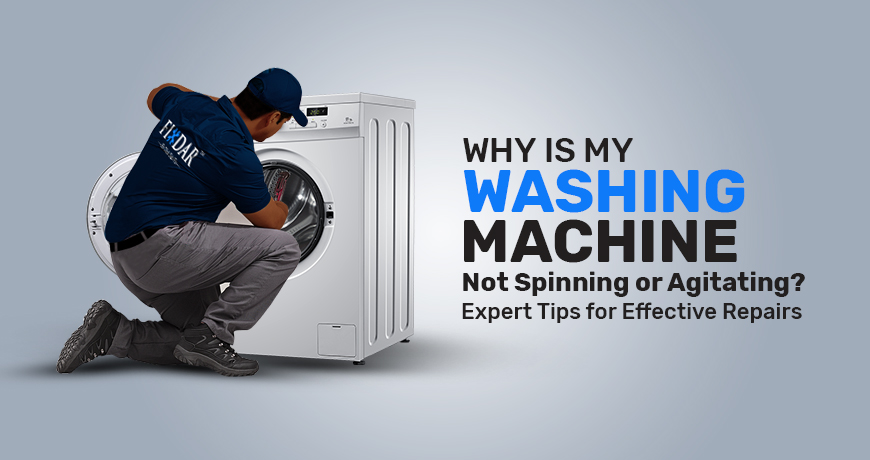Welcome to our comprehensive troubleshooting guide for washing machines that are experiencing issues with spinning or agitating. If you’ve ever found yourself wondering, “Why is my washing machine not spinning or agitating?” then you’re in the right place. In this expert-backed article, FixDar will delve into the common causes behind this problem and provide you with valuable tips and techniques to address it effectively.
When your washing machine fails to spin or agitate, it can disrupt your laundry routine and leave you frustrated. However, understanding the underlying reasons behind this issue is crucial for successful electrical appliances repairs. From a malfunctioning drive belt or motor coupling to problems with the lid switch or transmission, there are several potential culprits.
Our team of experts has curated a list of proven troubleshooting methods that will help diagnose and resolve these issues efficiently. By following our step-by-step instructions and utilizing expert tips, you’ll be well-equipped to tackle the challenge head-on.
Don’t let a non-spinning or non-agitating washing machine bring your laundry routine to a halt! Join us as we explore effective solutions in our troubleshooting guide: “Why Is My Washing Machine Not Spinning or Agitating? Expert Tips for Effective Repairs.”
Common Causes of Washing Machine Spinning/Agitating Issues
When your washing machine fails to spin or agitate, it can be frustrating and inconvenient. Understanding the common causes behind these issues is essential for effective troubleshooting. Here are some of the most frequent culprits:
• Drive Belt Issues: A worn-out or broken drive belt can prevent the drum from spinning properly. Over time, belts can become loose, damaged, or simply wear out due to regular use.
• Motor Coupling Problems: The motor coupling connects the motor to the transmission and enables spinning and agitation. If it becomes worn out or breaks, it can cause a loss of functionality in these areas.
• Faulty Lid Switch: Washing machines have lid switches that ensure safety by stopping operation when the lid is open. If this switch malfunctions or gets stuck, it may prevent spinning and agitating.
• Transmission Troubles: The transmission plays a vital role in regulating speed and direction during cycles. Any issues with gears, seals, or other components within the transmission system can disrupt spinning and agitation functions.
Checking the Drive Belt: A Key Component in Spin and Agitation Functions
Checking the drive belt is a crucial step when troubleshooting a washing machine that is not spinning or agitating. The drive belt is responsible for transferring power from the motor to the drum, enabling these essential functions. Here’s how you can examine and address potential issues with the drive belt:
• Visual Inspection: Start by unplugging your machine and accessing the back panel or bottom of the unit. Inspect the drive belt for signs of wear, fraying, or damage. If you notice any visible issues such as cracks or breaks, it’s likely time to replace the belt.
• Tension Adjustment: A loose or improperly tensioned drive belt can also cause spinning/agitating problems. Check if there is enough tension on the belt by pressing it firmly with your finger; it should have about an inch of give.
• Belt Alignment: Ensure that the drive belt aligns properly with all pulleys and gears in its path without slipping off track.
If you discover any problems during this inspection, consult your washing machine’s manual for specific instructions on replacing or adjusting the drive belt. By addressing potential issues with this key component, you can restore proper functionality to your washing machine’s spin and agitation functions.
Step-by-Step Troubleshooting Process for Non-Spinning or Non-Agitating Machines
When faced with a washing machine that is not spinning or agitating, following a step-by-step troubleshooting process can help identify and resolve the underlying issues. Here’s a comprehensive guide to assist you in diagnosing and addressing the problem effectively:
• Check Power Supply: Ensure that your washing machine is receiving power by verifying connections, circuit breakers, and fuses.
• Examine Drive Belt: Inspect the drive belt for signs of wear, damage, or improper tension. Replace or adjust it if necessary.
• Test Motor Coupling: Assess the motor coupling for any faults such as cracks or wear. Replace it if required.
• Verify Lid Switch Functionality: Confirm that the lid switch is engaging properly when closed to allow operation.
• Evaluate Transmission Components: Inspect gears, seals, and other transmission parts for any defects or malfunctions.
• Test Electronic Control Board: If applicable, check the electronic control board for error codes or faulty signals that may affect spinning/agitation functions.
By meticulously going through each of these steps in order, you can systematically troubleshoot non-spinning/non-agitating washing machines and address specific issues accordingly.
Conclusion
In conclusion, armed with the expert tips provided in this troubleshooting guide, you can confidently diagnose and resolve issues preventing your washing machine from spinning or agitating. Say goodbye to laundry woes and enjoy a fully functional appliance once again.






